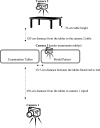Influences of Clinician Technique on Performance and Interpretation of the Lachman Test
- PMID: 12937470
- PMCID: PMC155509
Influences of Clinician Technique on Performance and Interpretation of the Lachman Test
Abstract
OBJECTIVE: To examine the influences of clinician technique on performance and interpretation of the Lachman test. DESIGN AND SETTING: Blinded, controlled, and randomized-block design clinical study conducted in an athletic training laboratory classroom. SUBJECTS: Twenty-two certified athletic trainer clinicians and 12 model patients. MEASUREMENTS: We used video analyses of 3-dimensional kinematics to identify variations in clinician technique. Each clinician's technique was classified according to the demonstrated grip configuration and test style. RESULTS: Clinician grip configuration was found to relate to performance and interpretation of the Lachman test. Clinicians demonstrating proximal "tibia-hand" placement were more likely to correctly perform and interpret the Lachman test than clinicians demonstrating distal tibia-hand placement. CONCLUSIONS: Clinicians should use the correct techniques when attempting to evaluate and interpret athletic injuries.
Figures
Similar articles
-
Accurate interpretation of the Lachman test.Clin Orthop Relat Res. 1986 Dec;(213):163-6. Clin Orthop Relat Res. 1986. PMID: 3780086
-
Accuracy and reliability of anterior cruciate ligament clinical examination in a multidisciplinary sports medicine setting.Clin J Sport Med. 2010 Mar;20(2):80-5. doi: 10.1097/JSM.0b013e3181ceca45. Clin J Sport Med. 2010. PMID: 20215888
-
Similarities and differences of diagnostic manual tests for anterior cruciate ligament insufficiency: a global survey and kinematics assessment.Am J Sports Med. 2012 Jan;40(1):91-9. doi: 10.1177/0363546511423634. Epub 2011 Oct 11. Am J Sports Med. 2012. PMID: 21989128
-
Examiner proficiency in performing the anterior drawer and Lachman tests.J Orthop Sports Phys Ther. 1995 Dec;22(6):263-6. doi: 10.2519/jospt.1995.22.6.263. J Orthop Sports Phys Ther. 1995. PMID: 8580954
-
VORL Test and its Interpretation.Indian J Dermatol Venereol Leprol. 1983 Sep-Oct;49(5):233-239. Indian J Dermatol Venereol Leprol. 1983. PMID: 28176703 Review. No abstract available.
Cited by
-
THE DIAGNOSTIC ACCURACY OF THE LEVER SIGN FOR DETECTING ANTERIOR CRUCIATE LIGAMENT INJURY.Int J Sports Phys Ther. 2017 Dec;12(7):1057-1067. doi: 10.26603/ijspt20171057. Int J Sports Phys Ther. 2017. PMID: 29234557 Free PMC article.
-
RELIABILITY OF ANKLE-FOOT MORPHOLOGY, MOBILITY, STRENGTH, AND MOTOR PERFORMANCE MEASURES.Int J Sports Phys Ther. 2017 Dec;12(7):1134-1149. doi: 10.26603/ijspt20171134. Int J Sports Phys Ther. 2017. PMID: 29234565 Free PMC article.
-
A novel digital arthrometer to measure anterior tibial translation.J Orthop Surg Res. 2023 Feb 13;18(1):101. doi: 10.1186/s13018-022-03497-4. J Orthop Surg Res. 2023. PMID: 36782204 Free PMC article.
-
Diagnosis and treatment of anterior cruciate ligament injuries: Consensus of Chinese experts part II: Graft selection and clinical outcome evaluation.J Orthop Translat. 2024 Aug 23;48:163-175. doi: 10.1016/j.jot.2024.07.002. eCollection 2024 Sep. J Orthop Translat. 2024. PMID: 39257437 Free PMC article.
-
The reliability and diagnostic accuracy of assessing the translation endpoint during the lachman test.Int J Sports Phys Ther. 2015 Feb;10(1):52-61. Int J Sports Phys Ther. 2015. PMID: 25709863 Free PMC article.
References
-
- Newell KM, Kugler PN, van Emmerik REA, McDonald PV. Search strategies and the acquisition of coordination. In: Wallace SA, editor. Perspectives on the Coordination of Movement. Amsterdam, Netherlands: Elsevier Science Publishers; 1989. pp. 85–122.
-
- Newell KM, McDonald PV. Searching for solutions to the coordination function: learning as exploratory behavior. In: Stelmach GE, Requin J, editors. Tutorials in Motor Behavior II. Amsterdam, Netherlands: North-Holland; 1982. pp. 517–532.
-
- Newell KM, Valvano J. Therapeutic intervention as a constraint in learning and relearning movement skills. Scand J Occup Ther. 1998;5:23–35.
-
- Bonnarens FO, Drez D., Jr . Clinical examination of the knee for anterior cruciate ligament laxity. In: Jackson DW, Drez D Jr, editors. The Anterior Cruciate Deficient Knee: New Concepts in Ligament Repair. Washington, DC: Mosby; 1987. pp. 72–88.
-
- Irrgang JJ, Safran MR, Fu FH. The knee: ligamentous and meniscal injuries. In: Zachazewski JE, Magee DJ, Quillen WS, editors. Athletic Injuries and Rehabilitation. Philadelphia, PA: WB Saunders; 1996. pp. 623–692.
LinkOut - more resources
Full Text Sources




